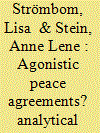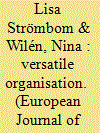| Srl | Item |
| 1 |
ID:
187033


|
|
|
|
|
| Summary/Abstract |
Later years have seen the growth of a vibrant theoretical discussion on agonistic peace and the importance of creating space for contestation, plurality, and dissensus post-accord. However, there has been very few attempts at embedding agonistic theory in empirical analyses of peace agreements. This study attends to that lacuna by investigating how agonistic principles can be integrated and investigated in peace agreements. We suggest a threefold set of indicators for assessing the degree to which peace agreements are invested with agonistic dynamics: (1) what types of spaces for interaction are offered post-accord; (2) what forms of inclusion are stipulated; and (3) how is the peace agreement framed in terms of conflict termination and consensus/dissensus? We illustrate how the various indicators could be put into motion in concrete analyses applying them to examples from the Oslo Accords, the Belfast Agreement, and the Colombian Peace Agreement. Finally, we discuss four dilemmas and problematiques of integrating agonistic ideas in peace agreements; the issue of power, the mixing of agonistic and liberal ideals in peace agreements, the principle of ‘nothing is agreed until everything is agreed’ and the related double-edged potential of constructive ambiguity and finally the challenges of implementing peace agreements.
|
|
|
|
|
|
|
|
|
|
|
|
|
|
|
|
| 2 |
ID:
183891


|
|
|
|
|
| Summary/Abstract |
What roles are military institutions expected to play in today's rapidly changing security environment? How are they supposed to interact with the society they are tasked to protect? These questions have been posed by classical military sociologists as well as by a newer generation of scholars. Yet so far, a comprehensive mapping of the military's potential roles in contemporary society is missing. In this article we contribute to an update of this debate by providing a categorisation of the different roles and tasks that the military institution plays in current industrialised democratic states. We identify three core roles, each divided into subroles, by drawing on an extensive reading of 70 National White Papers and Security Strategies from 37 OECD member states: (collective) defence, collective security, and aid to the nation. We analyse how these roles and tasks influence recent configurations in civil-military relations. This study thereby contributes with: (1) a useful illustration of the military's shifting roles and tasks in contemporary society; (2) increased understandings of how the different roles impact civil-military relations and related to this; and (3) a practical starting point for further analyses of the military organisation's internal challenges related to its, at times, contradictory roles.
|
|
|
|
|
|
|
|
|
|
|
|
|
|
|
|